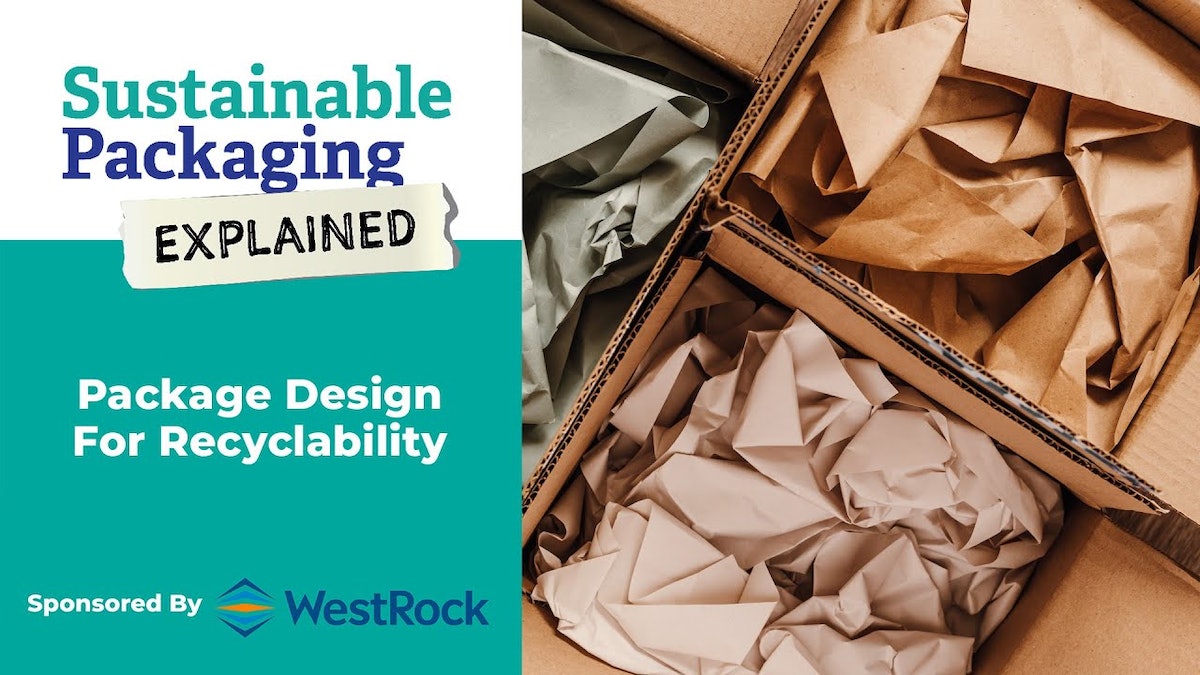
Welcome to Sustainable Packaging Explained, your guide to sustainable materials, methods, and package design produced by the Emerging Brands Alliance in conjunction with Packaging World. In today’s episode, we will explore considerations of package design for recyclability. According to the organization How to Recycle, packaging is recyclable if it can be collected, sorted, reprocessed, and ultimately reused in manufacturing or making another item.
Brands Big and Small are looking at package design and setting goals for recyclability. Colgate Palmolive plans to reach 100 percent recyclable, reusable, or compostable packaging for all its categories by 2025. P& G’s goal is 100 percent recyclable or reusable packaging by 2030. And Nestle has committed to 100 percent recyclable or reusable packaging by 2025.
One of the keys to designing packages that are easily recycled is through careful material selection. Choosing the right materials is essential for ensuring that packaging can be effectively sorted and processed [00:01:00] in recycling facilities. And the easiest way to do that is to stick to a single material type.
Combining paper and plastic, or aluminum and plastic, or adding some types of coatings will affect recyclability. There are many guides available based on the chosen material, such as the APR Design Guide for Plastics Recyclability, or the American Forest and Paper Association’s Design Guide for Recyclability, or the Consumer Goods Forum’s Golden Design Rules.
Look for materials that are widely accepted in recycling systems, such as paper or plastics labeled with recycling codes number 1 for PET or number 2 for HDPE. These materials have established markets and are more easily recycled. Opt for plastic materials with clear or natural colors. Vibrant or dark colors can complicate the sorting process and reduce the quality of recycled materials.
And consider that when using transparent PET, the total supply of high quality recycled PET increases, enabling a viable closed loop recycling pathway. Additionally, consider the following recycling requirements when designing your package. [00:02:00] Size and shape. Some shapes are more accepted at recycling facilities, such as plastic bottles, jugs, and jars.
Labels and adhesives. Use labels and adhesives that can be easily removed during the recycling process. Excessive labeling or the use of incompatible adhesives can hinder recycling. Thin films and flexible packaging can be problematic at recycling facilities and unnecessary overwraps should not be used.
A final note about making your package design recyclable is to include recycling instructions for the consumer directly on the package. One new development is a 2023 program in conjunction with Recycle Check and the Recycling Partnership that will include local recycling acceptance on a package in the form of a QR code.
Package data is submitted by brands and cross referenced against the National Recycling Database to give up to date local recycling information. You can also check out platforms such as HowToRecycle and SmartLabel for guidance on how to educate consumers.[00:03:00]
Now let’s take a look at some inspiring examples of packaging that has been specifically designed for recyclability like the GreenBox Pizza Box. This innovative design is made from 100 percent recycled cardboard and features perforated sections that can easily be torn off and recycled separately, reducing waste and improving recyclability.
Packaging World editor Matt Reynolds tells us more about recyclability. For a Coca Cola company brand like Sprite, there’s a lot of brand equity tied up in familiarity of color and shelf appearance. That’s why it’s always notable when a brand like Sprite, traditionally sold in green PET when in plastic bottle formats, [00:04:00] shifts to a clear PET bottle.
Now, clear PET contributes to higher quality bales of ARPET, and that ARPET contributes to a needed supply and desirable, more widely available, end market. Percentages of PCR in ARPET will grow over time as a result of this simple change. Meanwhile, plastic films are moving toward monomaterial status when possible.
These are technically recyclable films, unlike multi layer laminations and excrusions of multi layer, multi material packs. But, infrastructure at MRFs, or Material Recovery Facilities, that sorts curbside recyclables, they have a really tough time with these materials, as they get wrapped around equipment and generally just gum up the works.
So today, the only solution is in store drop off, which imposes a hurdle for consumers. Friction, or any extra steps, that’s the enemy of consumers compliance with recycling suggestions on a package. As far as package size and shape is concerned, consider smaller, generally plastic containers for [00:05:00] cosmetics or hotel sized personal care products.
Such small packs are often difficult for screens at MRFs to catch and properly sort. Now, PhD students at MIT, along with the Sustainability Consortium and its members, like Estee Lauder Companies and Ulta Beauty, are working on mechanical sortation solutions to better recover cosmetics and small format packaging.
But as a brand is designing small format packages, they must be aware of what’s recoverable and sortable, not just what’s technically recyclable according to material alone. Speaking of improved sortation, consider Europe’s Holy Grail 2. 0 initiative. It uses digital watermarks, often invisible to consumers, that brands print directly onto the packaging.
While consumers don’t even know that the digital watermark is there, near infrared and other scanning equipment at recovery facilities and MRFs can read the data associated with each pack’s digital watermark and immediately know how to sort it. Early tests have proven to be very promising, with great recovery rates and cleaner bales.
Larger scale testing is rolling out soon. Remember [00:06:00] to incorporate these design principles and also conduct a comprehensive life cycle analysis to help you determine the optimal choice for your unique circumstances. Thanks for watching and be sure to subscribe to our YouTube channel for more videos on packaging and scaling operations and Join us at the Emerging Brands Alliance for year round resources to grow your brand.
